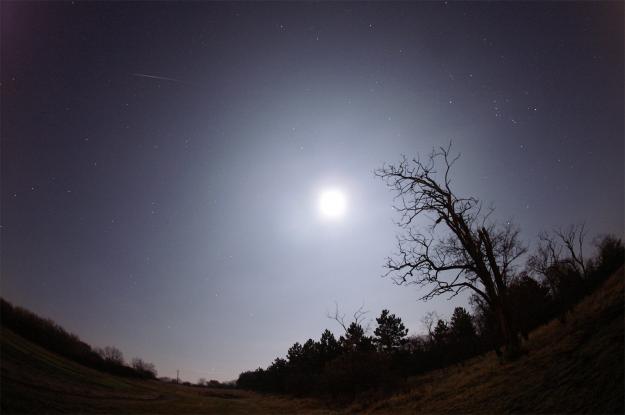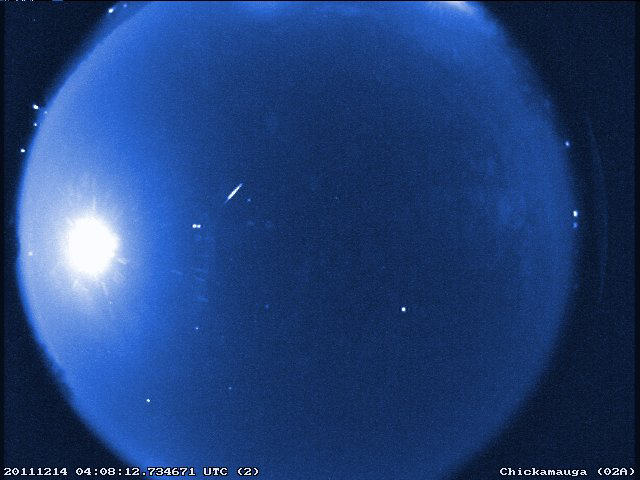Geminid Meteor Shower Wows Skywatchers Despite Bright Moon

Die-hard skywatchers around the world caught a dazzling "shooting star" light show Tuesday night (Dec. 13) during the peak of the annual Geminid meteor shower.
The Geminid meteor shower is often one of the best meteor displays of the year, but this year the event peaked just days after a total lunar eclipse and the December full moon, which threatened to wash out the sky show. But that didn't stop meteor shower enthusiasts from venturing out into the chilly December night for the celestial event.
"Despite the bright moonlight I could see more than two dozens of nice Geminids during the two hours I could spend outside!" skywatcher and photographer Monika Landy-Gyebnar, of Veszprem, Hungary, told SPACE.com in an email.
Landy-Gyebnar and a friend watched the Geminids from two different spots outside their hometown, keeping in contact via telephone. "I saw some really bright Geminids which fell outside the cameras' field of view near the zenith, also saw some fainter ones farther away from the Moon. All of them were quick and had no color. Many fell around the constellation Orion which were charming to see!" she added. [Skywatcher Photos: 2011 Geminid Meteor Shower]
Landy-Gyebnar also had some critter company during her skywatching trek. Her photos showed bright streaks lighting up the night sky.
"My only companions were two foxes who squalled near me talking to each other very loudly, although I could not see them, they might have been watching the Geminid shower among the bushes," she said. "It was a very good experience with much more meteors … so I can only suggest anyone to watch the sky as much as possible because bad circumstances are not always so bad!"
The Geminid meteor shower is an annual sky show created by pieces of the weird asteroid 3200 Phaethon, which sheds dusty debris. As the Earth passes through this debris field each year, the space rock remnants burn up in the atmosphere to create eye-catching fireballs and meteors.
Breaking space news, the latest updates on rocket launches, skywatching events and more!
The meteor shower appears to emanate from the constellation Gemini, which is where its name comes from.
A dependable sky show
Landy-Gyebnar was by no means the only skywatcher to look up during the Geminids' peak.
In British Columbia, Canada, photographer and amateur astronomer Daniel Stanyer braved the chilly December night and parked his camera on the roof of his car to snap photos. One dazzling fireball passed out of range of Stanyer's camera, but the next one streaked right across his field of view.
"Right away I looked over at the camera to see if the shutter was open or not. It was a long wait to the end of the 15 second exposure from there. I was very excited to see that I had captured the entire thing, and called it a night right there," he said. "All in all I saw 21 in the hour I was out, with 12 of those the slow streaking kind, 9 dimmer faster ones, and the one fireball. It's been a great couple days with the lunar eclipse and now this meteor show."
Delightful December meteors
Skywatcher Mike Hankey of Freeland, Md., said the bright moonlight didn't put a damper on his Geminid experience either.
"The shower seemed pretty active and this is the best crop of meteor photos I've had all year," Hankey told SPACE.com. "That is pretty amazing, considering there was a near full moon and we got clouded out at 2:00 a.m."
Hankey created a composite time-lapse photo that captured many of the meteors he spotted in a single image.
"I captured 11 meteors on camera last night before the clouds came in," Hankey said. I put together a composite image with 7 of the best meteor shots. It turned out pretty good."
NASA astronomers also got into the spirit of the Geminid meteor shower, with the space agency hosting a late-night webchat and live stream from all-sky cameras across the south-east.
In a post-meteor shower wrap up, Bill Cooke, head of NASA's Meteoroid Environment Office at the Marshall Space Flight Center in Huntsville, Ala., said that clouds blocked much of the camera views Tuesday night.
"However, we managed to capture a few images before viewing was obscure," Cooke wrote in a blog.
Some eager skywatchers did not snap photos of the Geminid meteor shower, but were still amazed by the event.
"I've only been outside for 1/2 an hour and I've already seen 9 meteors! WOW!" observer Stacey Mohamed wrote SPACE.com from Kissimmee, Fla. "I have made sure to watch every meteor shower this year and by far this is the best! Maybe it's because I'm a Gemini myself!"
The next shooting star display to grace Earth's night skies will be the Ursid meteor shower, which peaks on Dec. 22. But skywatchers should wait until 2012 for more impressive displays.
The first meteor display of 2012 will be the Quadrantid meteor shower, which peaks on Jan. 3.
You can follow SPACE.com Managing Editor Tariq Malik on Twitter @tariqjmalik. Follow SPACE.com for the latest in space science and exploration news on Twitter @Spacedotcomand on Facebook.

Tariq is the award-winning Editor-in-Chief of Space.com and joined the team in 2001. He covers human spaceflight, as well as skywatching and entertainment. He became Space.com's Editor-in-Chief in 2019. Before joining Space.com, Tariq was a staff reporter for The Los Angeles Times covering education and city beats in La Habra, Fullerton and Huntington Beach. He's a recipient of the 2022 Harry Kolcum Award for excellence in space reporting and the 2025 Space Pioneer Award from the National Space Society. He is an Eagle Scout and Space Camp alum with journalism degrees from the USC and NYU. You can find Tariq at Space.com and as the co-host to the This Week In Space podcast on the TWiT network. To see his latest project, you can follow Tariq on Twitter @tariqjmalik.

![Astrophotographer Mike Hankey in Freeland, MD, said: "I set up my camera around 8:00 PM [Dec. 13, 2011] and photographed continuously through the night. The sky was clear until about 2:00 am and then covered with clouds for the rest of the evening. I was able to catch a total of 11 meteors in that 6 hour window. That’s pretty good considering there was a near full moon for most of the evening."](https://cdn.mos.cms.futurecdn.net/Z8VRH6hnCNMch4FaPmWgBS.jpg)

